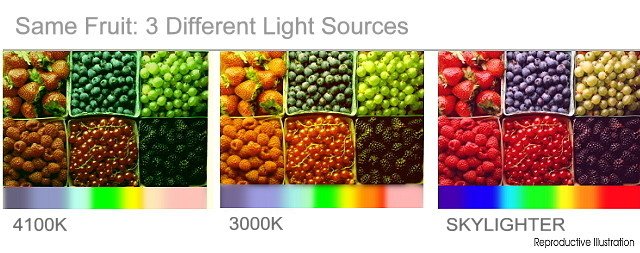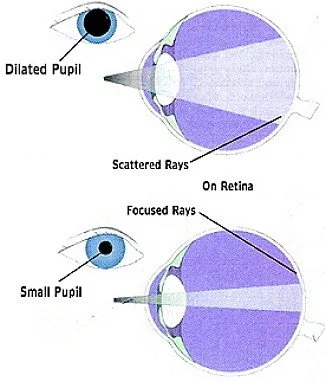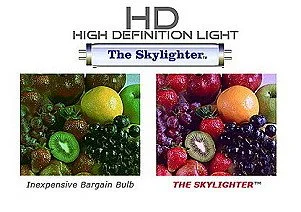THE SAD NEWS ABOUT SAD LIGHTS
According to the Mayo Clinic, Seasonal affective disorder (SAD) is a type of depression that's related to changes in seasons — SAD begins and ends at about the same times every year. If you're like most people with SAD, your symptoms start in the fall and continue into the winter months, sapping your energy and making you feel moody. These symptoms often resolve during the spring and summer months.
Often touted as a treatment are “SAD lights”, or full spectrum artificial lighting to trick your body into thinking that more daylight is available to offset the symptons of SAD. Maybe. Maybe not.
To continue this discussion, there are some vocabulary terms we must undertstand about lighting.
Lamp Color Temperature. This standard was created using a reference piece of metal, heated up, and linking the color it glows at what temperature; measured in Kelvins.
The old fashioned incandescent filament lamps burned between 2800-3200 Kelvins, a warm yellowish light.
The once-widely used fluorescent “cool white” was 4100 Kelvin, a dull white with a tinge of subtle green.
Outdoor daylight can range from 5000-7500 Kelvin, depending on season, time of day, and direction of sunlight. 5500 Kelvin is the usual “standard”, although the deep Northern sky can be 7500 Kelvin or better.
Color Rendering Index (CRI). This rating determines how accurate colors appear under any given light source. The outdated low pressure sodium street lights emitted a single frequency of pure yellow. Objects under a low pressure lamps appeared black and white, thus, a color rendering of 0 (zero).
Various fluorescent lamps generally rated from mid 50’s to mid 70’s, with a few higher rated exceptions, “Deluxe Cool White” and the pinkish “Natural”. When Duro-Test introduced the “full spectrum” Vita Lite, the CRI was closer to 90. In 2004, Winbeam Light Labs improved upon the Vita Lite by making better use of scotopic energy and deep reds found in natral sunlight. Discussion of scotopic versus photopic light are important in understanding how the eye responds to light- but is beyond the scope of this discussion. Searches for theses terms will bring you to plenty of insightful reading.
Incandescent lamps are rated at 100 CRI @ 3000 Kelvin. Outdoor sunlight also rates at 100 CRI but @ 5500 Kelvin.
This seems odd that two very different light sources and colors can both be 100 percent accurate in color rendering. However, there are two standards of CRI, one at 3000K and the other for outdoor daylight.
Lumens. How much light a lamp produces, or, how bright a given space is. Can be calculated into LUX.
An example of the same display as seen under three different light sources. “The Skylighter” was considered to be a “full spectrum”, or more accurately, and “Equalized Spectrum” lamp.
The eye is least sensitive to reds. When outdoors, there is so much red light available, it makes little difference.
However, undeer the typical lower levels of indoor light, extra red needs to be manufactured into the lamp for reds to be rendered properly. This is the basis for an “Equalized Spectrum”.
Mass produced fluorescents lamps used a cheap orange phosphor to get into the reds.
This is a prime reason fluorescent lighting was not flattering.
The Skylighter used an expensive rare earth phosphor to reproduce deep reds.
Scotopic light at 507 nanometers is what the rod cells, your black and white (and low light) receptors see. It ALSO triggers a reflex which closes the pupil. Just like a camera, the smaller the lens, the greater the depth of field. This can notably improve reading.
The color cone cells in your eyes respond to photopic light, which peaks at 550 nanometers. The more energy at 550, the brighter a lamp appears to be. However, a lamp can only produce a given amount of light per watt, concentrating too much at 550 will sacrifice the other portions of the spectrum, resulting in poor overall light quality.
(Scroll down for more)
Duro-test had marketed their Vita-Lite as a treatment for SAD, but without peer reviewed double blind studies to support that claim, the Vita-Lite was then sold as a “color accurate” lamp. It, along with The Skylighter were marketed to dentists for color matching of teeth. Prior to High CRI lighting, the patient needed to be walked outside for a color match.
Today, all sorts of companies are marketing all sorts of "full spectrum’ table lamps and lightboxes as a treatment for Seasonal affective disorder. They have the high color temperature, they have the high CRI. However, what is missing are the lumens needed to trigger a signifigant response in the body. Yes, high CRI and a high Kelvin lamp, and indoor levels may mildly bring down meletonin and although unproven, may make one more alert.
However, before buying a “SAD LIGHT”, consider this. Direct noon summer daylight provides approximately 100,000 lux (lumens per square meter). A 48 inch 5000 Kelvin LED tube produces about 2000 lumens, spread over 10 square meters results in an illuminance of 100 lux.
You would need to be in a space, no larger than 10 square meters with 10,000 full spectrum LEDS shining on you for a SAD-LIGHT to be effective in warding off seasonal affective disorder.
High CRI rated lamps, 90 or better with a high Kelvin (at least 5000K) can make merchandise more appealing, people and furnishings look better; they likely have little effect on mood unless light levels are summer-noon bright.
However, as a side note for retailers. As we did our exhaustive research for The Skylighter, we learned about what we call “the moth effect”. The better lit and brighter a space is, the more customers will come in, and even spend more money. An example was 4 gas stations on the same corner. Drivers spent a few cents more at the brightly lit station, rather than the darker cheaper station.
With all this being said, there ARE benefits to spending a bit more money on a high CRI lamp. The space will simply look better. With higher Kelvin lamps which have a bump in scotopic energy (507 nanometers), the eye will better focus.
Keep in mind as well, that a space lit with a low Kelvin lamp, will appear smaller and cozy. Same space lit with a high Kelvin lamp will appear larger and cleaner.
The author: Matt Locker, founder of Winbeam Light Labs, LLC and developer of “The Skylighter”, the first equalized spectrum fluorescent lamp.
The manufacture of fluorescent lamps was outlawed in August 2024, in favor of energy efficient LED’s. Existing stock may be sold or used.
As such, Winbeam Light Labs, LLC has folded. This page is solely for reference material. If you have questions, comments, or corrections, please reach out through the contact tab. (C) 2025 All Rights Reserved.







